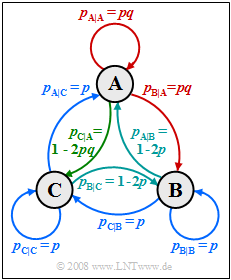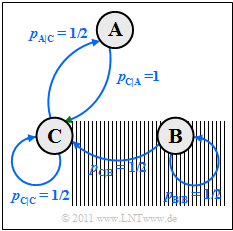Aufgaben:Aufgabe 1.6Z: Ternäre Markovquelle: Unterschied zwischen den Versionen
K (Textersetzung - „*Sollte die Eingabe des Zahlenwertes „0” erforderlich sein, so geben Sie bitte „0.” ein.“ durch „ “) |
|||
| Zeile 3: | Zeile 3: | ||
}} | }} | ||
| − | [[Datei:Inf_Z_1_6_vers2.png|right|Ternäre Markovquelle]] | + | [[Datei:Inf_Z_1_6_vers2.png|right|frame|Ternäre Markovquelle]] |
Die Grafik zeigt eine Markovquelle mit $M = 3$ Zuständen $\rm A$, $\rm B$ und $\rm C$. Für die beiden Parameter dieses Markovprozesses soll gelten: | Die Grafik zeigt eine Markovquelle mit $M = 3$ Zuständen $\rm A$, $\rm B$ und $\rm C$. Für die beiden Parameter dieses Markovprozesses soll gelten: | ||
:$$0 \le p \le 0.5 \hspace{0.05cm},\hspace{0.2cm}0 \le q \le 1 \hspace{0.05cm}.$$ | :$$0 \le p \le 0.5 \hspace{0.05cm},\hspace{0.2cm}0 \le q \le 1 \hspace{0.05cm}.$$ | ||
| Zeile 11: | Zeile 11: | ||
:$$H = 2 \cdot H_{\rm 2} - H_{\rm 1} \hspace{0.05cm}.$$ | :$$H = 2 \cdot H_{\rm 2} - H_{\rm 1} \hspace{0.05cm}.$$ | ||
| − | *Nach der | + | *Nach der <i>direkten Berechnungsmethode</i> kann die Entropie aber auch wie folgt berechnet werden (insgesamt 9 Terme): |
| − | :$$H = p_{\rm AA} \cdot {\rm | + | :$$H = p_{\rm AA} \cdot {\rm log_2}\hspace{0.1cm}\frac {1}{ p_{\rm A\hspace{0.01cm}|\hspace{0.01cm}A}} + p_{\rm AB} \cdot {\rm log_2}\hspace{0.1cm}\frac {1}{ p_{\rm B\hspace{0.01cm}|\hspace{0.01cm}A}} + \ \text{...} |
\hspace{0.05cm}, \ | \hspace{0.05cm}, \ | ||
\text{wobei} \ p_{\rm AA} = p_{\rm A} \cdot p_{\rm A\hspace{0.01cm}|\hspace{0.01cm}A} \hspace{0.05cm},\hspace{0.2cm} | \text{wobei} \ p_{\rm AA} = p_{\rm A} \cdot p_{\rm A\hspace{0.01cm}|\hspace{0.01cm}A} \hspace{0.05cm},\hspace{0.2cm} | ||
| − | p_{\rm AB} = p_{\rm A} \cdot p_{\rm B\hspace{0.01cm}|\hspace{0.01cm}A} \hspace{0.05cm}, \ | + | p_{\rm AB} = p_{\rm A} \cdot p_{\rm B\hspace{0.01cm}|\hspace{0.01cm}A} \hspace{0.05cm}, \ \text{...}$$ |
| + | |||
| + | |||
| + | |||
| + | |||
''Hinweise:'' | ''Hinweise:'' | ||
| Zeile 27: | Zeile 31: | ||
<quiz display=simple> | <quiz display=simple> | ||
| − | {Für welche Parameter $p$ und $q$ ergibt sich die maximale Entropie pro Symbol? | + | {Für welche Parameter $p$ und $q$ ergibt sich die maximale Entropie pro Symbol? |
|type="{}"} | |type="{}"} | ||
| − | $p \ = $ { 0.333 1% } | + | $p \ = \ $ { 0.333 1% } |
| − | $q\ = $ { 1 1% } | + | $q\ = \ $ { 1 1% } |
| − | $H_\text{max} \ = $ { 1.585 1% } $\ \rm bit/Symbol$ | + | $H_\text{max} \ = \ $ { 1.585 1% } $\ \rm bit/Symbol$ |
| − | {Es sei $p = 1/4$ und $q = 1$. Welcher Wert ergibt sich in diesem Fall für die erste Entropienäherung? | + | {Es sei $p = 1/4$ und $q = 1$. Welcher Wert ergibt sich in diesem Fall für die erste Entropienäherung? |
|type="{}"} | |type="{}"} | ||
| − | $H_1 = \ $ { 1.585 3% } $\ \rm bit/Symbol$ | + | $H_1 = \ \ $ { 1.585 3% } $\ \rm bit/Symbol$ |
| − | {Weiterhin gelte $p = 1/4$ und $q = 1$. Welcher Wert ergibt sich in diesem Fall für die zweite Entropienäherung? | + | {Weiterhin gelte $p = 1/4$ und $q = 1$. Welcher Wert ergibt sich in diesem Fall für die zweite Entropienäherung? |
|type="{}"} | |type="{}"} | ||
| − | $H_2 = \ $ { 1.5425 1% } $\ \rm bit/Symbol$ | + | $H_2 = \ \ $ { 1.5425 1% } $\ \rm bit/Symbol$ |
| − | {Wie groß ist die tatsächliche Quellenentropie mit $p = 1/4$ und $q = 1$? | + | {Wie groß ist die tatsächliche Quellenentropie mit $p = 1/4$ und $q = 1$? |
|type="{}"} | |type="{}"} | ||
| − | $H = \ $ { 1.5 1% } $\ \rm bit/Symbol$ | + | $H = \ \ $ { 1.5 1% } $\ \rm bit/Symbol$ |
| − | {Wie groß ist die tatsächliche Quellenentropie mit $p = 1/2$ und $q = 0$? | + | {Wie groß ist die tatsächliche Quellenentropie mit $p = 1/2$ und $q = 0$? |
|type="{}"} | |type="{}"} | ||
| − | $H = \ $ { 0.667 1% } $\ \rm bit/Symbol$ | + | $H = \ \ $ { 0.667 1% } $\ \rm bit/Symbol$ |
Version vom 19. September 2018, 09:44 Uhr
Die Grafik zeigt eine Markovquelle mit $M = 3$ Zuständen $\rm A$, $\rm B$ und $\rm C$. Für die beiden Parameter dieses Markovprozesses soll gelten:
- $$0 \le p \le 0.5 \hspace{0.05cm},\hspace{0.2cm}0 \le q \le 1 \hspace{0.05cm}.$$
Aufgrund der Markoveigenschaft dieser Quelle kann die Entropie auf unterschiedliche Weise ermittelt werden:
- Man berechnet die beiden ersten Entropienäherungen $H_1$ und $H_2$. Dann gilt für die tatsächliche Entropie:
- $$H = 2 \cdot H_{\rm 2} - H_{\rm 1} \hspace{0.05cm}.$$
- Nach der direkten Berechnungsmethode kann die Entropie aber auch wie folgt berechnet werden (insgesamt 9 Terme):
- $$H = p_{\rm AA} \cdot {\rm log_2}\hspace{0.1cm}\frac {1}{ p_{\rm A\hspace{0.01cm}|\hspace{0.01cm}A}} + p_{\rm AB} \cdot {\rm log_2}\hspace{0.1cm}\frac {1}{ p_{\rm B\hspace{0.01cm}|\hspace{0.01cm}A}} + \ \text{...} \hspace{0.05cm}, \ \text{wobei} \ p_{\rm AA} = p_{\rm A} \cdot p_{\rm A\hspace{0.01cm}|\hspace{0.01cm}A} \hspace{0.05cm},\hspace{0.2cm} p_{\rm AB} = p_{\rm A} \cdot p_{\rm B\hspace{0.01cm}|\hspace{0.01cm}A} \hspace{0.05cm}, \ \text{...}$$
Hinweise:
- Die Aufgabe gehört zum Kapitel Nachrichtenquellen mit Gedächtnis.
- Bezug genommen wird insbesondere auf die Seite Nichtbinäre Markovquellen.
- Bei allen Entropien ist die Pseudoeinheit „bit/Symbol” hinzuzufügen.
Fragebogen
Musterlösung
(1) Die maximale Entropie ergibt sich dann, wenn die Symbole $\rm A$, $\rm B$ und $\rm C$ gleichwahrscheinlich und die Symbole innerhalb der Folge statistisch voneinander unabhängig sind. Dann muss gelten:
- $p_{\rm A} = p_{\rm A|A} = p_{\rm A|B} = p_{\rm A|C} = 1/3$,
- $p_{\rm B} = p_{\rm B|A} = p_{\rm B|B} = p_{\rm B|C} = 1/3$,
- $p_{\rm C} = p_{\rm C|A} = p_{\rm C|B} = p_{\rm C|C} = 1/3$.
Daraus lassen sich die gesuchten Werte bestimmen:
- Beispielsweise erhält man aus $p_{\rm C|C} = 1/3$ der Wert $p \hspace{0.15cm}\underline{= 1/3}$.
- Berücksichtigt man noch die Beziehung $p_{\rm A|A} = p \cdot q$, so folgt $q \hspace{0.15cm}\underline{= 1}$.
- Damit ergibt sich die maximale Entropie $H_\text{max} ={\rm ld} \ 3\hspace{0.15cm}\underline{= 1.585\ \rm bit/Symbol}$.
(2) Mit den Parameterwerten Übergangsdiagramm für $p = 1/4$ und $q = 1$ ergibt sich das nebenstehende Übergangsdiagramm, das folgende Symmetrien aufweist:
- $p_{\rm A|A} = p_{\rm B|B} = p_{\rm C|C} = 1/4$ (rot markiert),
- $p_{\rm A|B} = p_{\rm B|C} = p_{\rm C|A} = 1/2$ (grün markiert),
- $p_{\rm A|C} = p_{\rm B|A} = p_{\rm C|CB} = 1/4$ (blau markiert).
Es ist offensichtlich, dass die Symbolwahrscheinlichkeiten alle gleich sind:
- $$p_{\rm A} = p_{\rm B} = p_{\rm C} = 1/3 \hspace{0.3cm} \Rightarrow \hspace{0.3cm} H_1 = {\rm ld}\hspace{0.1cm} 3 \hspace{0.15cm} \underline {= 1.585 \,{\rm bit/Symbol}} \hspace{0.05cm}.$$
(3) Für die zweite Entropienäherung benötigt man die $3^2 = 9$ Verbundwahrscheinlichkeiten. Mit dem Ergebnis der Teilaufgabe (2) erhält man hierfür:
- $$p_{\rm AA} = p_{\rm BB}= p_{\rm CC}= p_{\rm AC}=p_{\rm BA}=p_{\rm CB}=1/12 \hspace{0.05cm},\hspace{0.5cm} p_{\rm AB} = p_{\rm BC}=p_{\rm CA}=1/6$$
- $$\Rightarrow \hspace{0.2cm} H_2 = \frac{1}{2} \cdot \left [ 6 \cdot \frac{1}{12} \cdot {\rm ld}\hspace{0.1cm} 12 + 3 \cdot \frac{1}{6} \cdot {\rm ld}\hspace{0.1cm} 6 \right ] = \frac{1}{4} \cdot {\rm ld}\hspace{0.1cm} 4 + \frac{1}{4} \cdot {\rm ld}\hspace{0.1cm} 3 + \frac{1}{4} \cdot {\rm ld}\hspace{0.1cm} 2 + \frac{1}{4} \cdot {\rm ld}\hspace{0.1cm} 3 = \frac{3}{4} + \frac{{\rm ld}\hspace{0.1cm} 3}{2} \hspace{0.15cm} \underline {= 1.5425 \,{\rm bit/Symbol}} \hspace{0.05cm}.$$
(4) Aufgrund der Markoveigenschaft der Quelle gilt
- $$H = 2 \cdot H_2 - H_1 = [ {3}/{2} + {\rm ld}\hspace{0.1cm} 3] - {\rm ld}\hspace{0.1cm} 3\hspace{0.15cm} \underline {= 1.5 \,{\rm bit/Symbol}} \hspace{0.05cm}.$$
Zum gleichen Ergebnis würde man mit folgender Rechnung kommen:
- $$H= p_{\rm AA} \cdot {\rm ld}\hspace{0.1cm}\frac {1}{ p_{\rm A\hspace{0.01cm}|\hspace{0.01cm}A}} + p_{\rm AB} \cdot {\rm ld}\hspace{0.1cm}\frac {1}{ p_{\rm B\hspace{0.01cm}|\hspace{0.01cm}A}} + ... \hspace{0.1cm}= 6 \cdot \frac{1}{12} \cdot {\rm ld}\hspace{0.1cm} 4 + 3 \cdot \frac{1}{16} \cdot {\rm ld}\hspace{0.1cm} 2 \hspace{0.15cm} \underline {= 1.5 \,{\rm bit/Symbol}} \hspace{0.05cm}.$$
(5) Aus dem nebenstehendenm Übergangsdiagramm mit den aktuellen Parametern erkennt man, dass bei Stationarität $p_{\rm B} = 0$ gelten wird, da $\rm B$ höchstens zum Starzeitpunkt einmal auftreten kann. Es liegt also eine binäre Markovkette mit den Symbolen $\rm A$ und $\rm C$ vor. Die Symbolwahrscheinlichkeiten ergeben sich zu:
- $$p_{\rm A} = 0.5 \cdot p_{\rm C} \hspace{0.05cm}, \hspace{0.2cm}p_{\rm A} + p_{\rm C} = 1 \hspace{0.3cm} \Rightarrow \hspace{0.3cm} p_{\rm A} = 1/3 \hspace{0.05cm}, \hspace{0.2cm} p_{\rm C} = 2/3\hspace{0.05cm}. $$
Damit erhält man folgende Wahrscheinlichkeiten:
- $$p_{\rm A\hspace{0.01cm}|\hspace{0.01cm}A} \hspace{0.1cm} = \hspace{0.1cm}0\hspace{0.7cm} \Rightarrow \hspace{0.3cm} p_{\rm AA} = 0 \hspace{0.05cm},$$
- $$ p_{\rm A\hspace{0.01cm}|\hspace{0.01cm}C} =1/2\hspace{0.3cm} \Rightarrow \hspace{0.3cm} p_{\rm CA} = p_{\rm C} \cdot p_{\rm A\hspace{0.01cm}|\hspace{0.01cm}C} = 2/3 \cdot 1/2 = 1/3 \hspace{0.05cm},\hspace{0.2cm}{\rm ld}\hspace{0.1cm}(1/p_{\rm A\hspace{0.01cm}|\hspace{0.01cm}C} )= 1\hspace{0.05cm},$$
- $$ p_{\rm C\hspace{0.01cm}|\hspace{0.01cm}A} =1\hspace{0.7cm} \Rightarrow \hspace{0.3cm} p_{\rm AC} = p_{\rm A} \cdot p_{\rm C\hspace{0.01cm}|\hspace{0.01cm}A} = 1/3 \cdot 1 = 1/3 \hspace{0.05cm},\hspace{0.61cm}{\rm ld}\hspace{0.1cm}(1/p_{\rm C\hspace{0.01cm}|\hspace{0.01cm}A} )= 0\hspace{0.05cm},$$
- $$ p_{\rm C\hspace{0.01cm}|\hspace{0.01cm}C} =1/2\hspace{0.3cm} \Rightarrow \hspace{0.3cm} p_{\rm CC} = p_{\rm C} \cdot p_{\rm C\hspace{0.01cm}|\hspace{0.01cm}C} = 2/3 \cdot 1/2 = 1/3\hspace{0.05cm},\hspace{0.2cm}{\rm ld}\hspace{0.1cm}(1/p_{\rm C\hspace{0.01cm}|\hspace{0.01cm}C} )= 1 $$
- $$\Rightarrow \hspace{0.25cm} H = p_{\rm AA} \cdot {\rm ld}\hspace{0.1cm}\frac {1}{ p_{\rm A\hspace{0.01cm}|\hspace{0.01cm}A}} +p_{\rm CA} \cdot {\rm ld}\hspace{0.1cm}\frac {1}{ p_{\rm A\hspace{0.01cm}|\hspace{0.01cm}C}}+ p_{\rm AC} \cdot {\rm ld}\hspace{0.1cm}\frac {1}{ p_{\rm C\hspace{0.01cm}|\hspace{0.01cm}A}} + p_{\rm CC} \cdot {\rm ld}\hspace{0.1cm}\frac {1}{ p_{\rm C\hspace{0.01cm}|\hspace{0.01cm}C}}= 0 + 1/3 \cdot 1 + 1/3 \cdot 0 + 1/3 \cdot 1 \hspace{0.15cm} \underline {= 0.667 \,{\rm bit/Symbol}} \hspace{0.05cm}.$$

